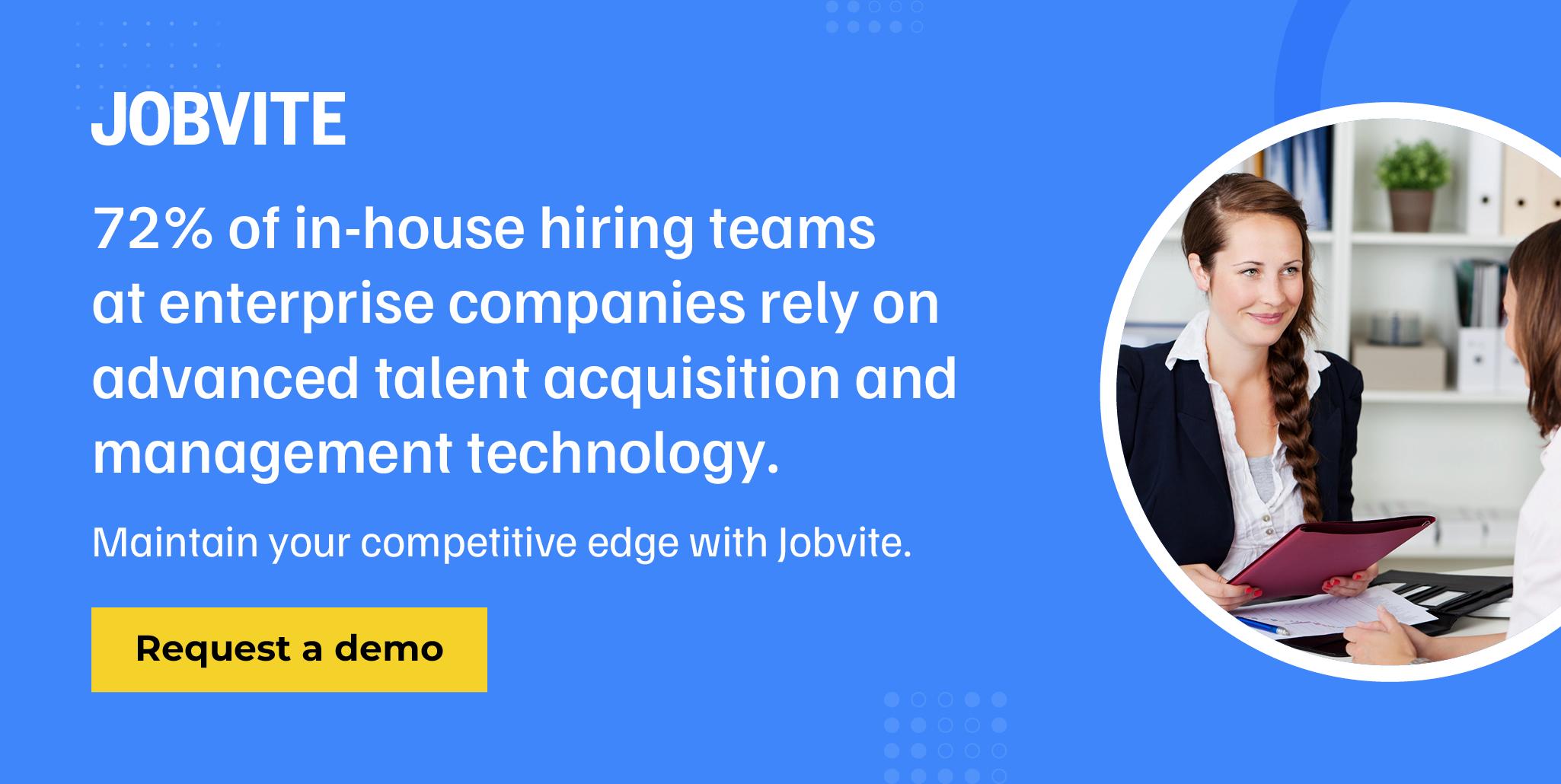
Your organization’s definition of an effective talent acquisition strategy likely differs from other large-scale enterprises because of your unique goals, challenges, complexities, and hiring needs.
Yet every business requires a solid approach to recruiting and hiring. And there are tried-and-true recruitment approaches that leading enterprises use to grow and scale their companies. This guide examines these tactics and identifies how to implement them, so you can optimize your talent acquisition strategies across your enterprise.
- What is talent acquisition?
- 10 highly effective talent acquisition strategies
- Tips for implementing talent acquisition strategies enterprise-wide

What is talent acquisition?
Before we get into the strategies, let’s review exactly what talent acquisition is and isn’t. While some people use the term interchangeably with recruitment, they’re actually different concepts. Take a look at these distinctions from Jobvite’s Guide to Recruitment and Talent Acquisition.
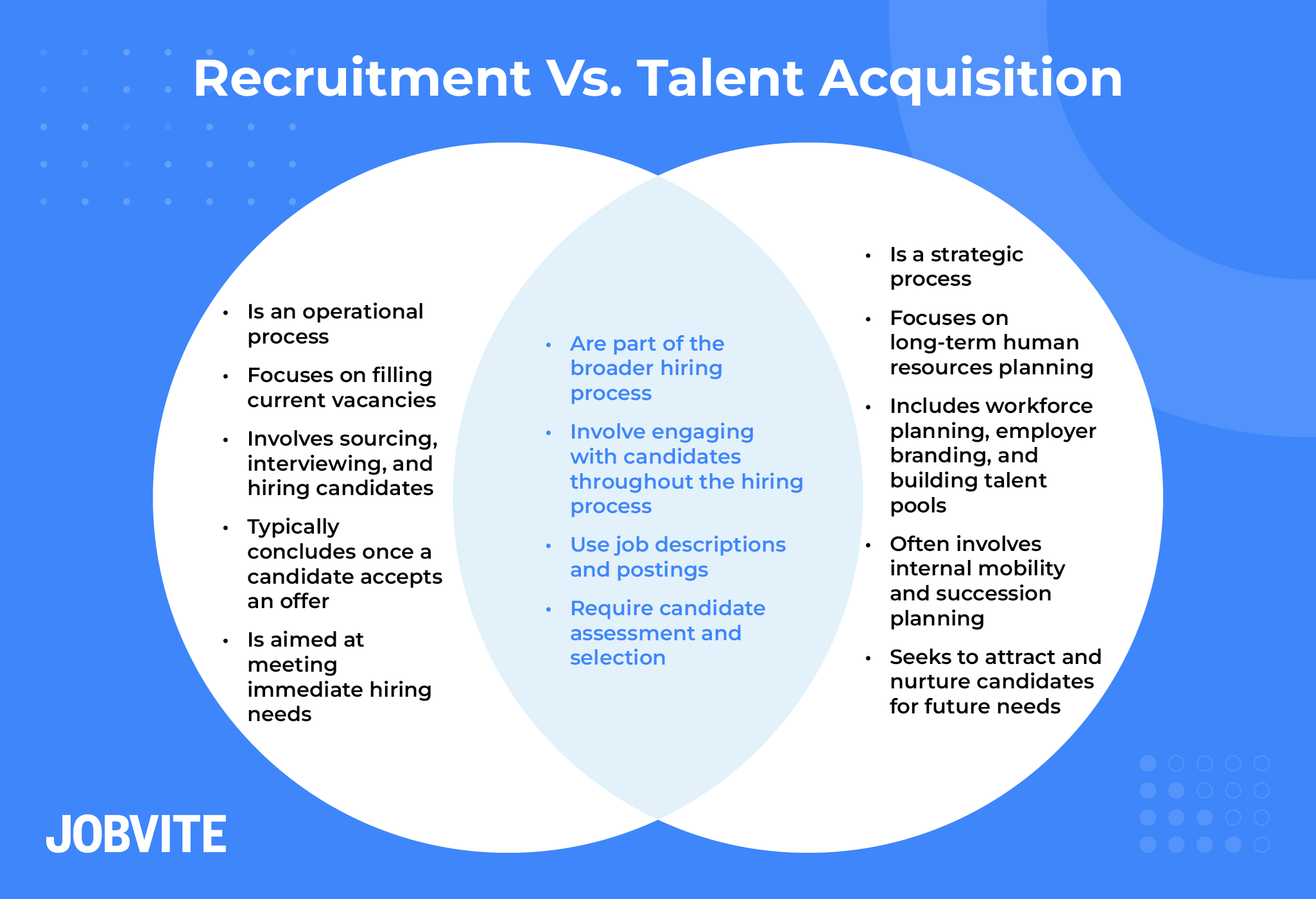
- Recruitment:
- Operational process
- Focuses on filling current vacancies
- Involves sourcing, interviewing, and hiring candidates
- Typically concludes once a candidate accepts an offer
- Aimed at meeting immediate hiring needs
- Talent Acquisition:
- Strategic process
- Focuses on long-term human resources planning
- Includes workforce planning, employer branding, and building talent pools
- Often involves internal mobility and succession planning
- Seeks to attract and nurture candidates for future needs
- Talent Acquisition and Recruitment:
- Parts of the broader hiring process
- Involve engaging with candidates throughout the hiring process
- Use job descriptions and postings
- Require candidate assessment and selection
Essentially, talent acquisition is a proactive, strategic process that occurs over a long period. Recruitment is a shorter-term focus that emphasizes immediate hiring needs.
10 highly effective talent acquisition strategies
Between the time hiring managers submit a requisition to fill a job opening and a candidate accepts an offer, your talent team identifies, engages, and advances top-tier prospects throughout the recruitment funnel by:
- Nurturing top talent from your sourcing channels
- Leveraging talent acquisition software with database and pipeline management capabilities
- Screening strong-fit candidates whose skills align with job postings
- Introducing those individuals to hiring managers through further interview rounds
- Working with the hiring team to help decide which prospects deserve offers and extending offers accordingly
- Collecting candidate feedback from interview panelists to gauge their sentiment
The following strategies complement and optimize these processes, providing your talent team with key talent analytics that can inform future strategy moves.
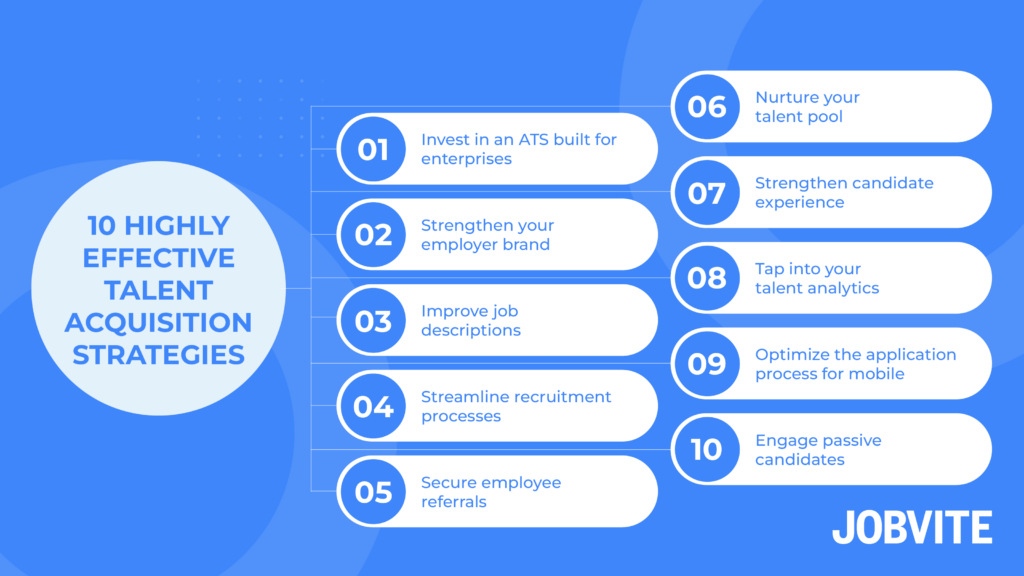
1. Invest in an applicant tracking system built for enterprises
Using an applicant tracking system (ATS) sets the groundwork for a strong talent acquisition strategy. After all, it allows you to track metrics, build relationships with candidates efficiently, pinpoint areas for improvement within your talent acquisition strategies, and more.
Look for a robust solution built for enterprises with significant hiring needs. For instance, Jobvite offers a top ATS for enterprises. The Jobvite ATS is part of the Evolve Talent Acquisition Suite, empowering you to invest in and optimize important processes like:
- Recruitment marketing
- Candidate experience
- Interviewing
- DEI initiatives
- Candidate sourcing
- Analytics and reporting
Regardless of the solutions you choose, ensure that you can create custom reports, automate tasks, and collaborate with your enterprise-wide team, so you can effectively roll out and improve your talent acquisition strategies.
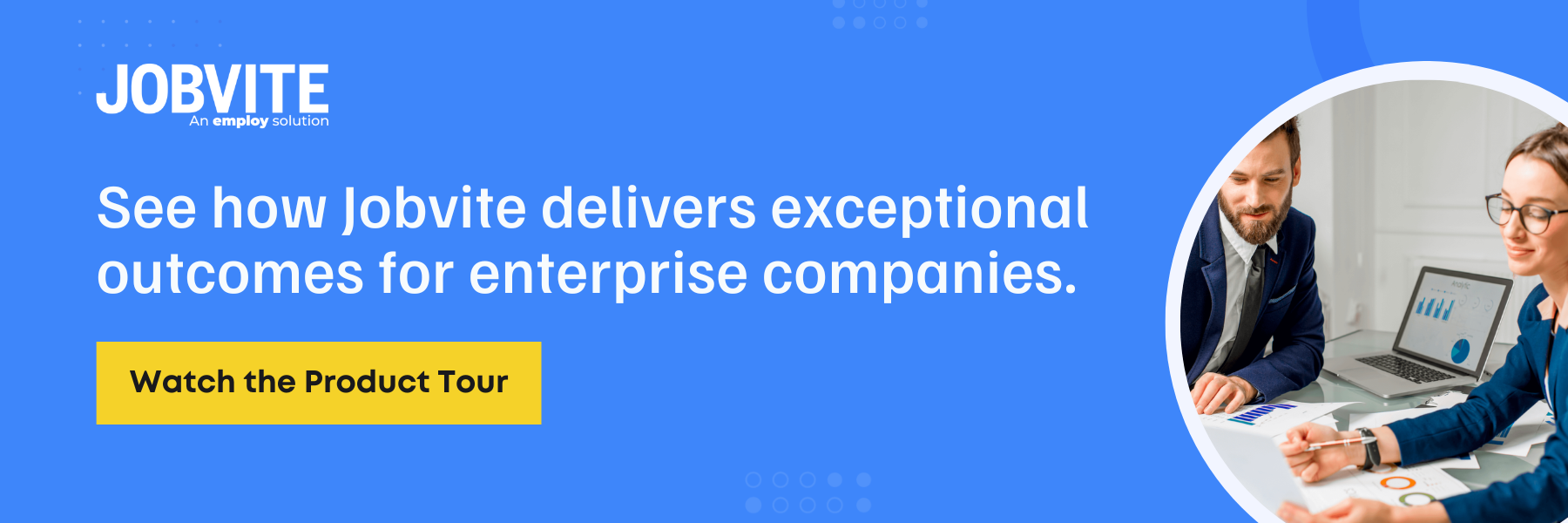
2. Strengthen your employer brand
Your reputation as a business and an employer can greatly impact your hiring outcomes. So, creating a compelling and distinctive employer brand is crucial for a successful talent acquisition strategy.
Your employer brand expresses what it’s like to work in your company, and should resonate with potential candidates and set the tone for their entire candidate experience. An effective employer brand includes:
- A clear mission and vision statement
- Transparency about company culture
- Competitive compensation and benefits packages
- Well-defined career paths and growth opportunities
- Positive employee testimonials and engagement
By highlighting these aspects of your employer brand on your website, social media, job boards, and other candidate touchpoints, you will make your organization more appealing to the top candidates on the market.
3. Improve your job descriptions
Clear, concise, and engaging job descriptions attract the top candidates. By focusing on the specific skill sets required for an open role and showcasing your company culture and benefits, your job postings will be more likely to resonate with the right audience.
Just ensure your job descriptions are:
- Succinct yet specific, outlining essential responsibilities and qualifications
- Fully inclusive, using positive language and tone
- Aligned with your company culture, values, and employer brand
- Feature recognizable keywords for enhanced searchability on job boards
Also, look beyond traditional job boards and explore new ways of reaching your target demographic, such as niche job boards, industry forums, and social media. Wherever you post them, your job descriptions should paint a clear picture of the overall job expectations and offer an enticing look at your company.
4. Streamline your recruitment processes
Talent acquisition and recruiting processes go hand-in-hand. With that in mind, ensure your recruitment processes complement your talent acquisition strategies in scope, approach, and quality. Try these tips to create a seamless recruitment process that enhances the candidate experience and mitigates the loss of top candidates to your competitors:
- Leverage automation: Automate repetitive tasks, such as candidate tracking and interview scheduling, to simplify your recruitment processes.
- Collaborate with HR: Your HR department should be involved in recruitment through regular communication with department managers. Facilitate open communication channels for feedback and adjustments.
- Make your application process straightforward: Candidates expect a fast, intuitive application experience. Avoid abandoned applications by offering a good user experience and asking candidates for feedback on how you can improve.
By removing as many recruitment barriers, both for applicants and your team, as possible, you can appeal to the top candidates for your positions.
5. Secure more employee referrals
As an enterprise, you have thousands of employees who have contacts who could become potential applicants. Think about all the leads you could obtain from these connections.
That’s why leveraging employee referrals has proven to be one of the most effective talent acquisition strategies. Encourage members of your workforce to participate in your employee referral program by:
- Offering financial incentives
- Keeping the process straightforward and user-friendly
- Ensuring a positive company culture
Referral programs not only attract new hires, but also motivate current employees to participate in the hiring process, which can improve retention, loyalty, and your employer brand. Plus, they’re easy to manage with Jobvite’s Employee Referral tool.
6. Develop and nurture your talent pool
Building a strong talent pool provides a ready source of potential candidates for your talent team to engage, even when hiring is slow. Doing so can help you identify top contenders in your database for new requisitions that open up down the line.
Building this talent pool with your ATS is the first step. However, you also must actively engage with leads through targeted nurturing cadences: both personalized (check-ins with particular prospects) and semi-personalized (newsletters about brand updates to passive candidates).
By proactively engaging with and nurturing potential candidates, and informing them of job openings and company events, you can create a pipeline of talent ready to be tapped into when needed.
7. Strengthen your candidate experience
Your organization’s candidate experience is a crucial element to consider in your talent acquisition strategy. By analyzing your candidate experience, you can gauge if your hiring process is streamlined and transparent at every stage. To steadily enhance the quality of your candidate experience:
- Ensure job postings are clear, well-written, and accurately reflect the position
- Streamline application processes to mitigate candidate frustration and drop-off
- Communicate frequently to keep leads informed during the recruiting process
- Conduct respectful, transparent interviews and provide feedback afterward
Prioritizing and improving the candidate experience empowers you to not only attract top talent away from competitors, but also improve your company’s reputation and increase retention.
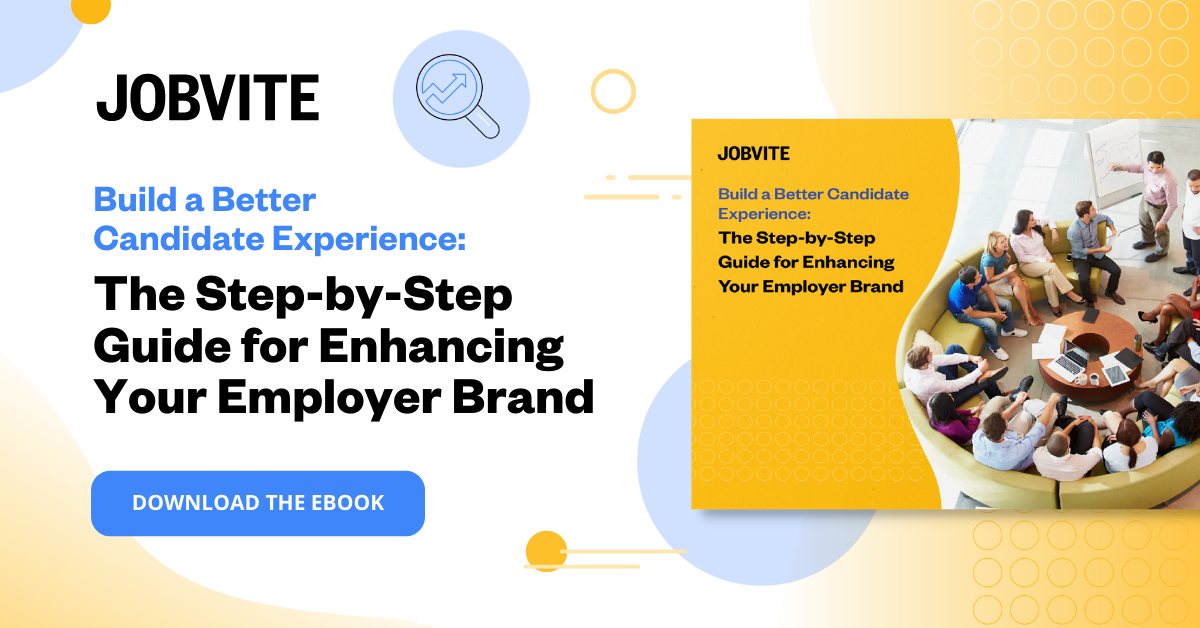
8. Tap into your talent analytics
Harness the power of your talent data to discover and engage potential candidates. Make data-driven decisions by using advanced analytics to:
- Understand which of your sources and nurture approaches are strongest
- Identify skill set gaps in your current workforce
- Forecast hiring needs based on projected company growth and attrition
- Uncover information about industry hiring trends through labor market reports
Measuring these metrics is vital to the success of any talent acquisition strategy. Ensure you have the correct tools to properly capture and evaluate these data points.
9. Optimize the application process for mobile
Reaching job candidates where they are is crucial, and today, many of them are on their phones. So, ensure that your job postings and application process are optimized for mobile devices.
By making the candidate’s mobile experience seamless, you will maximize the likelihood that they will engage with your recruitment marketing content and convert from candidates into applicants. Learn from the experience of Hearth & Home Technologies (HHT) to see how a strong mobile experience for job seekers impacted candidate engagement rates. By using Jobvite’s mobile-friendly tools, they were able to:
- Understand the behaviors of their candidates using Jobvite’s Intelligent Messaging
- Engage candidates through text, boosting candidate engagement and streamlining interview scheduling
- Increase candidate response rates by nearly 50%
10. Engage candidates from different niches
While most enterprises operate within a highly specific industry, your company should always be open to candidates from diverse backgrounds. Applicants with different worldviews can offer benefits such as:
- Fresh perspectives and innovation
- Enhanced problem-solving
- Adaptability
- Growth potential in new industries
- Opportunities for employee referrals
Broadening your background qualifications doesn’t have to happen overnight, either. As a talent acquisition strategy, this idea works best as a gradual, long-haul shift. That way, you can account for trends in your industry and within the hiring space at large and sustain long-term growth.
Tips for implementing talent acquisition strategies enterprise-wide
Even if you feel excited about implementing these talent acquisition strategies, you might also feel some hesitation. Trying new approaches across your entire enterprise can be a time-consuming and complex endeavor. However, you can get started with these key tips for enterprises:
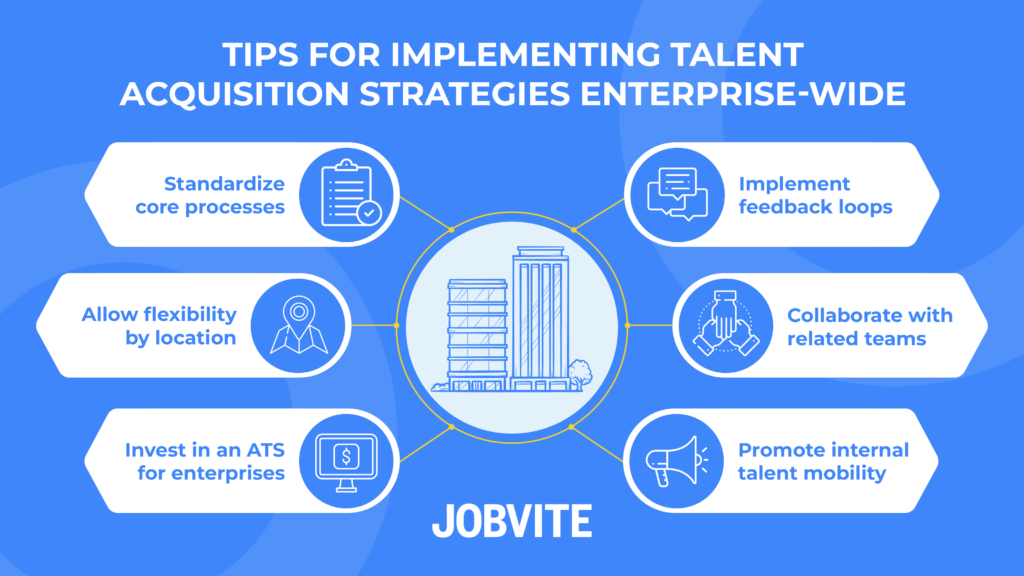
- Standardize core processes: Ensure that core processes, such as feedback loop management and candidate experience cadences, are standardized across the company.
- Allow flexibility by location and remote work: That said, it’s important to remember that different offices or remote hiring will have different priorities or processes. Work with hiring managers to ensure changes fit their unique workflows.
- Invest in an ATS and recruiting software for enterprises (like Jobvite): On an enterprise-wide level, ensure you have an optimized recruitment tech stack that aligns to your business goals and moves your business forward.
- Implement feedback loops: Every hiring team has its blind spots, which means every rollout depends on feedback. Collect feedback at all levels, so you can understand which strategies are working.
- Collaborate with related teams: Besides adjacent departments like HR, you’ll need the support of multiple teams with different functions in the company, along with executive leaders, to ensure adoption of these changes. Working with them ensures everyone is on the same page and improves the process with diverse perspectives.
- Promote internal talent mobility: Once employees have been with your enterprise for a significant period of time, they understand your company culture and have developed the necessary skills for leadership in their department. Promote internal talent mobility to mitigate sourcing demands, encourage employee skill development, and boost morale.
Get started with talent acquisition strategies
Adopting these talent acquisition strategies can help your enterprise attract and retain top candidates, leading to increased productivity, innovation, and stability. Make sure you start by investing in a streamlined hiring solution, like Jobvite, to deliver predictable hiring outcomes, create exceptional experiences, and increase recruiting capacity at scale. Schedule a demo to learn how our recruiting solutions can strengthen your talent acquisition strategy.
